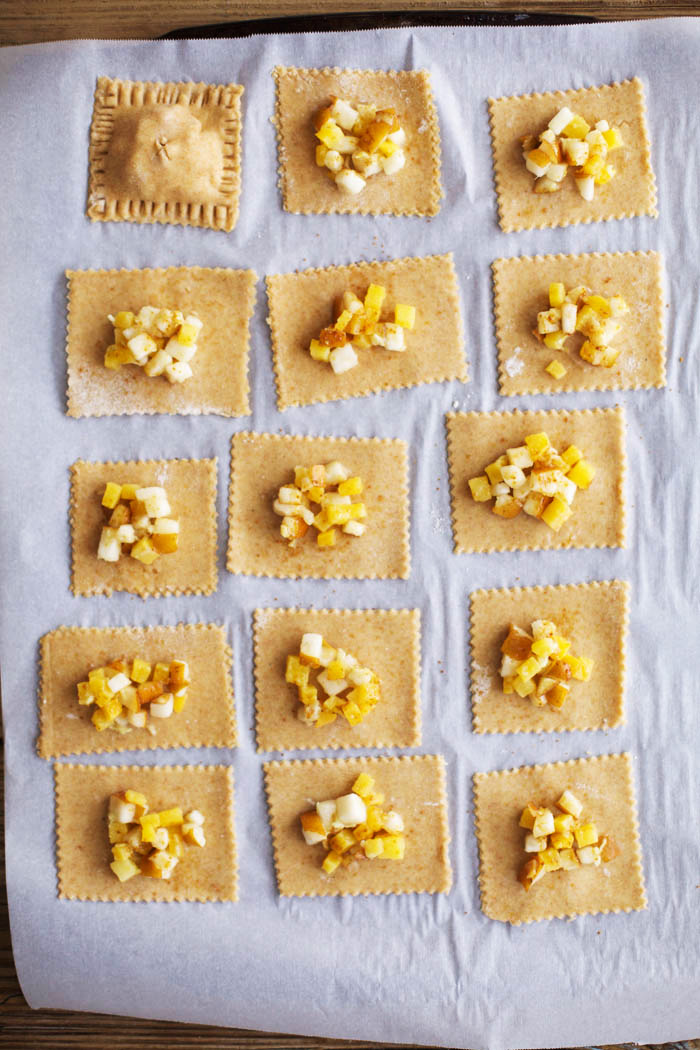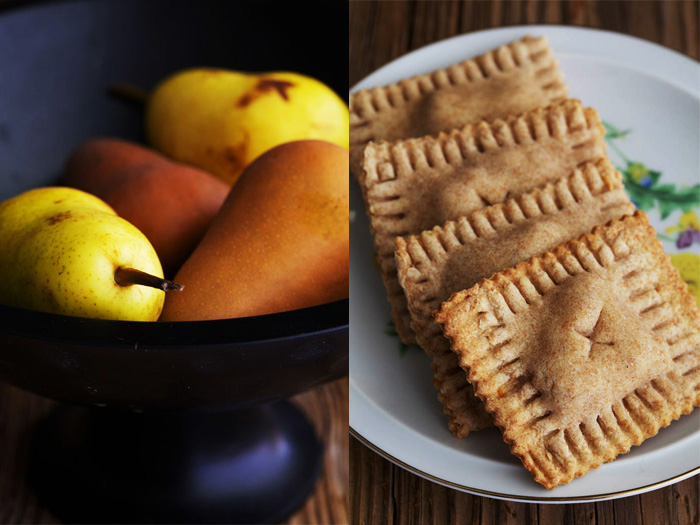
March 23rd, 2014

Finally, our plans have been set in stone, the tickets have been bought and all the arrangements made. Paloma and I are flying to Moscow in a month. We’re staying in the city for a day to see some friends and then jumping on a train for the 24-hour ride down south to my hometown. Paloma has never yet been to Russia, and as hard as I imagine the 12 hour flight will be for her, I’m sure she’ll love the train. The rest of the family will join us at the end of May, when we intend to visit to a couple of other places in our region, including Sochi. We’ll be back in the States just in time for our cookbook release day – June 10th. I am getting very excited to see family and friends, all of whom I haven’t seen in years. I am also dreaming about all the delicious Russian food I will inevitably consume, prepared by some of the best cooks in my book – my mom, aunt, and girlfriends.

As any Russian, I grew up eating a lot of pies (pirozhki in Russian). Yeasty, doughy shells stuffed with meats, cabbage, eggs, rice, sorrel, or fruit. My favorites were always cabbage pies, that my mom makes with lightly sauteed cabbage and hard boiled eggs. The dough recipe for pirozhki is a frequent conversation subject among many Russian women – everyone has their own secret to the perfect dough. The question of ingredients, ratios, types of yeast, and oven temperature are not to be taken lightly. These days, I try to avoid pirozhki as much as I can, but individual homemade pies take me back to family tea times of my childhood like nothing else.
Since I often experiment with healthier, lighter varieties of doughs and fillings, I decided to share this lighter handpie recipe I’ve been coming back to often throughout the winter. And before peas and asparagus take over the greenmarkets, I thought I’d squeeze in some nourishing wintry flavors one last time. The pies are a curious combination of sweet and savory in one shell, combined with the ever-balancing flavor of ginger. They are great to enjoy with a meal, a cup of tea, or as a snack to take to work or school.
And since there are so many inspiring handpie recipes in the world already, I thought I’d share my (most likely incomplete) list:
1. Despite how it may seem now, summer is not far – soon will be time to make Laura’s Strawberry Handpies and maybe even the ice cream too?
2. Lindsey’s gluten free Cranberry Poptarts with Ginger Glaze will definitely be in my dreams until the next cranberry season.
3. Ashlae’s mouthwatering Blackberry Jam Pies so beautifully presented by her inspiring photography.
4. Beth is a true handpie master, making all kinds of flavors work in her pie fillings – Muscadine Rose Handpies, White Peach Rose Basil Handpies, Blueberry Basil Goat Cheese Handpies.
5. Shauna’s dreamy Savoury Handpies, which gave me the idea to use rutabaga in mine. 
Gingery Rutabaga and Pear Handpies
makes about 15 handpies
for the dough
1 1/4 cups sprouted or whole spelt flour, or half each sprouted/whole and light spelt flour
1 teaspoon sea salt
1/2 tablespoon coconut sugar
generous 1/4 cup coconut oil – solid
2-3 tablespoons ice-cold water
for the filling
1/2 small yellow onion – diced
1 inch piece of fresh ginger root – peeled and minced
couple sprigs fresh thyme – optional
1/8 rutabaga – peeled and diced
pinch of sea salt
freshly ground black pepper – optional
1 ripe but firm pear – cored and diced
coconut sugar for sprinkling
to make the dough
1. Place the flour, salt and sugar in a food processor and pulse to mix.
2. Cut the coconut oil into small pieces and add to the food processor. Pulse until incorporated.
3. Add 2 tablespoons ice water and pulse until the dough comes together when pressed between fingers. If it’s too dry, add one more tablespoon of water.
4. Form a disc with the dough, wrap it in plastic wrap and refrigerate while making the filling.
to make the filling
1. Warm up about 1 tablespoon olive oil in a medium skillet. Add onion, ginger and thyme and cook, stirring, at medium heat for about 4 minutes.
2. Add in rutabaga, salt and pepper and cook for another 7-8 minutes.
3. Let cool slightly, then stir in the pear.
to make the handpies
1. Preheat oven to 375F (190C). Roll the dough on a lightly floured surface, to 1/8-inch thickness. Cut the dough into any shapes you prefer, using a pastry or cookie cutter, ravioli stamp or a shot glass. Reshape, re-roll and cut more, until all of the dough is used up.
2. Arrange half of the cut pieces on a parchment paper covered baking sheet. Spoon a small amount of filling on each piece and lightly sprinkle with coconut sugar. Cover with the rest of the dough sheets and press around the edges with a fork.
3. Place the tray into the freezer for 10 minutes. Take it out and quickly score or prick the tops to allow the steam to escape. Bake for 15-20 minutes until golden around the edges. Let cool. Store for about 3 days in an airtight container at cool temperature.
Tags: ginger, pear, rutabaga, snack

March 25th, 2012
This post is also available in: French
I recently re-discovered rutabaga and have been adding it to all sorts of recipes. I go through these phases with ingredients – one will become my favourite, and I will try to squeeze it into every dish I make. This lasts until I feel like I’ve come to know and understand the ingredient’s complexities and general temper. Then I can move on to the next thing.
Rutabaga is a root vegetable that has a mild flavour and hints at the freshness of a cabbage or turnip. Then it’s got a very delicate sweetness, which makes it versatile and great for both raw and cooked dishes. It is surprisingly delicious when simply peeled and sliced for a snack, maybe dipped in some almond butter. Steaming and roasting also yields very tasty results, of course.
As far as I know, rutabaga is a fairly uncommon ingredient. Let us correct that.
It has been a very long week for Paloma and I. Our papa has been away, taking a much needed break to do what he loves most – skiing in the mountains of Utah. We missed him dearly, and spent a lot of time together, going for walks, learning Russian, painting, and cooking this colourful pizza.
For the pizza crust, you can use almost any mild vegetable – rutabaga, jicama, zucchini, squash, or any mixture of those. We loved the crust topped with a spicy hummus spread, green olives, mushrooms, cherry tomatoes, and crispy sage. There are many possibilities with the toppings and herbs on this neutral crust – a perfect opportunity to get creative and enjoy some rutabaga.
Rutabaga and Crispy Sage Pizza
Pizza Crust
2 1/2 cups rutabaga, jicama, zucchini, etc., or combination – cubed
2 1/2 cups walnuts – soaked for 1 hour
1/2 cup ground flax seeds
1/4 cups hemp seeds
1/2 tablespoon sea salt
2 tablespoons purified water, more if needed
In a food processor, grind the vegetables into small pieces, making sure not to puree. Transfer into a large bowl. Place the walnuts into the food processor and pulse until choped into tiny pieces. Add the walnuts to the bowl with vegetables. Add the rest of the ingredients into the bowl. Mix to make a sticky dough, adjusting the amount of water if necessary.
Spread the dough on Teflex-lined dehydrator trays, forming a round pizza shape, or any other shape desired. I made one large and one small round pizza, utilizing two trays. Dehydrate at 115F for 6-8 hours. Flip, peel away the Teflex liner, and dehydrate on screens for another 3 hours or so. Once both sides are dry enough to handle, cut your pizzas into slices and dehydrate for another hour, or until the crust is steady and firm.
Spicy Hummus Spread
2 cups cashews – soaked for 2 hours
2 tablespoons raw sesame tahini
1-2 garlic cloves
1/4 cup lemon juice
1/2 teaspoon salt
dash of cayenne pepper
1/4 teaspoon ground cumin or more to taste
1/2 teaspoon ground coriander (optional)
1/2 cup purified water or more if needed
In a food processor, combine all the ingredients, with the exception of water. Add water gradually, until the hummus reaches a smooth and fluffy consistency.
Green Olive Tapenade
1 1/2 cups green olives such as Castelvetrano or Green Cerignola – pitted
1 handful fresh dill or parsley
1 tablespoon freshly squeezed lemon juice
1/4 cup olive oil
freshly ground black pepper
Chop the olives and herbs into small pieces and mix in the rest of the ingredients. You can also combine everything but the herbs in a food processor, adding in the herbs at the very end.
Marinated Mushrooms
2 cups shiitake or other mushrooms
a few sage leaves (optional)
1/2 cup each orange, lime, and lemon juice – freshly squeezed
1/4 cup olive oil
1 tablespoon sea salt
freshly ground black pepper
Mix all marinade ingredients and pour over the mushrooms. Stir to cover and marinate for 1-2 hours at room temperature. Drain.
Optionally, dehydrate the marinated sage leaves to a crispy consistency and use as a topping for pizza.
Assembly
Spread a thin layer of spicy hummus on the crust. Top with cherry tomatoes, marinated mushrooms, olive tapenade and/or olives. Sprinkle with crushed crispy sage.
Tags: mushrooms, olives, raw, recipe, rutabaga, sage, savoury, tomato, vegan




